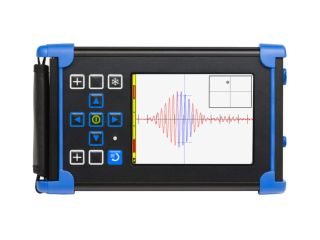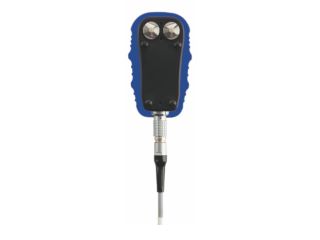Bond Testing
BondCheck
The new BondCheck is a multi-mode bond testing flaw detector providing high speed bond inspection in pitch-catch or resonance modes, or mechanical impedance analysis (MIA), with excellent defect sensitivity.
Inspection applications include those where carbon and metal honeycombs need to be inspected for delaminations, disbonds and core damage as well as small defect detection and dry coupling. The BondCheck is ideal for a wide spectrum of advanced material NDT of required in the aerospace, automotive, wind energy and advanced manufacturing sectors.
Advantages of the BondCheck include:
- Election of probe type available for different inspections
- Flip function, for left or right handed users

Overview
Housed in a lightweight instrument (1.2kg), with a common user interface between the three modes, the BondCheck delivers a simple and intuitive operator-led set up. The large daylight-readable display gives the BondCheck operator excellent data presentation and signal resolution. Users are able to configure colour schemes and use a secondary pane to create a split display with a choice of X-Y spot, frequency sweep, RF Waveform of spectrum displays; making the BondCheck an all round asset for inspection in the laboratory or out in the field.
The BondCheck Pitch-Catch Probe delivers high levels of performance and durability. Ergonomic design delivers robust and comfortable use. The position of the probe feet can be configured by the operator to suit the inspection task and the hard wearing probe tips are interchangeable; with rounded and flat tip profiles also available. The probe is broadband and is suitable for a wide range of applications.
BondCheck Resonance probes are available in a selection of frequencies (80, 100, 160, 200, 250 and 350kHz), and can also be supplied as a multi-probe kit. Both probe types have an Alarm LED and digital ID for ease of use, settings can be stored and “air calibration” is possible to establish the most sensitive inspection frequencies for your inspection.
The MIA technique is particularly useful for small defect detection, using a dry coupled probe with a small contact area. The technique offers excellent near surface defect sensitivity and is particularly suitable for top surface skin to core dis-bond detection for composite as well as metallic honeycomb structures.
Download our brochure:
BondCheck.pdf (1.4MB)
Features
- Multi-mode Bond Testing instrument
- Unique calibration function for fast and easy set-up
- Lightweight and portable
- Dry coupled pitch-catch and MIA probes
- Automatic Test Frequency Optimisation
- Ideal for inspection on metallic bonded structures, composite and metallic honeycomb
- 3 year warranty

Videos
Options
- Individual Resonance Probes or Resonance Probe Kit.
- Pitch-Catch Probes.
- MIA Probes

Specification
| Display | Type | 5.7” (145mm), 18 bit Colour, daylight readable. |
|---|---|---|
| Viewable Area | 115.2mm (Horizontal) x 86.4mm (Vertical). Resolution 640 x 480 pixels | |
| Colour Schemes | User configurable Dark, Bright and Black & White. | |
| Configurable Screen | Full Screen, Single, Dual Pane with variable size and location and function e.g. XY, Timebase. | |
| Display Modes | Pitch-Catch, Resonance & MIA: Spot and Sweep modes. RF Timebase for Pitch-Catch only. | |
| Graticules | None, Grid (4 sizes 5, 10, 15 and 20% FSH), Polar (4 sizes 5, 10, 15 and 20% FSH) | |
| Offset | Spot Position: Y -50 to +50, X -65 to +65% | |
| Flip | Manual or automatic screen orientation change to enable left or right handed use. | |
| Transmit | Operating Mode | Pitch-Catch / MIA Tone Burst |
| Output Frequency Range | Pitch Catch: 5kHz to 50kHz. Resonance: 50kHz to 500kHz MIA: 2kHz to 10kHz | |
| Output Voltage | Pitch-Catch tone burst: 10 ranges: 1,3,6,8,10,12,18,24,30,36V pk-pk. Pitch-Catch sweep: 3 ranges: 12, 24, 36V pk-pk. Resonance: 3 ranges: 12, 24, 36V pk-pk. MIA: 3 ranges: 12, 24, 36Vpk-pk (high voltage drive in probe). | |
| Minimum Output drive load impedance | 300 Ohms | |
| Waveform Type: Pitch-Catch/MIA | Tone burst with rectangular or hanning window with chirp. Transmit waveform points maximum: 8192. Waveform duration: Maximum 3.2ms / 2.5ms. Waveform output DAC clock rate: 2.5MHz fixed. Frequency Sweep: Frequency range 5kHz to 50kHz / 2kHz to 10kHz. | |
| Waveform Type: Resonance | Fixed or swept waveform Frequency range 5kHz to 500 kHz | |
| Receive | Pitch-Catch / MIA Tone Burst | Sample rate: 440kHz / 100kHz Maximum PRF: 14Hz Sample Bit depth: 12 bit Gain range: 0 to 60dB Receive bandwidth: 5kHz to 100kHz -6dB points Input voltage saturation: ±400mV Time base range: 100μs to 2ms/ 22ms Time base delay: 0μs to 1ms Cross Talk: >40dB isolation Amplitude/phase extraction cursor: position resolution <5μs /10μs |
| Resonance & Pitch-Catch Sweep | Dynamic Range: >150dB Bit depth: 24 bit Gain Range: -30 to 60dB Receive bandwidth: DC to 20MHz Amplitude/phase extraction by QAM demodulation | |
| Filtering | Fixed Hardware High-pass filter for Pitch-Catch to reduce surface scanning noise Fixed Hardware Low-pass filters 100kHz for Pitch-Catch for optimum amplifier SNR Configurable Software High-pass and Low-pass filters for all modes | |
| Software | Acquisition Gate in RF Mode | Adjustable gate start, width and threshold. |
| Alarm Gate in Y-T Mode | Multiple box, circle and sector alarm zones. | |
| Calibration Mode | Performs frequency sweep of bond and dis-bonded areas. Automatic inspection frequency determination with manual adjustment. Air calibration for resonance mode | |
| Bond/Dis-bond Alarm | Status on screen and probe LED. | |
| Removable Data Storage | Setup Storage | micro SD up to 32GB, holding over 10,000 settings |
| Stored Screen Shots | micro SD up to 32GB, holding over 10,000 screen shots | |
| Record Replay | Real-time recording of trace data and Replay on instruments and desktop PC up to 164 seconds | |
| Physical | Weight | 1.2 kg, 2.7 lbs |
| Size (w x h x d) | 237.5mm x 144mm x 52mm / 9.4” x 5.7” x 2.1” | |
| Material/Housing | Aluminium alloy Mg Si 0.5 powder-coated | |
| Operating/ Storage Temperature | Operating -20 to +60 °C Storage for up to 12 months -20 to +60 °C. Nominal +20 °C | |
| IP Rating | 54 | |
| Warranty | 3 year Manufacturer’s Warranty | Covers all components of the BondCheck, excludes customer damage or misuse. (probes not included) |

